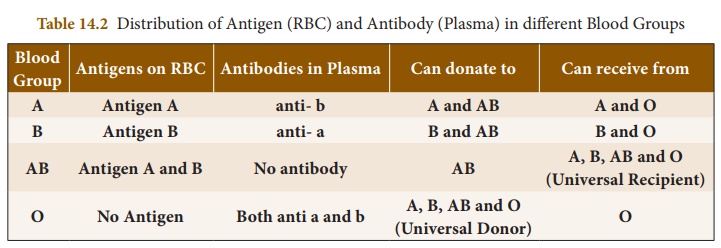Chapter: 10th Science : Chapter 14 : Transportation in Plants and Circulation in Animals
Blood Groups
Blood Groups
The concept of blood
grouping was developed by Karl Landsteiner (1900). He identified blood
groups A, B and O. AB blood group was recognized by Decastello
and Steini (1902).
Human blood contains
certain specific substances called agglutinogens or antigens (Ag)
and agglutinins or antibodies (Ab). Antigens are
found on the membrane surface of RBC. Antibodies are present in blood
plasma. Based on the presence or absence of antigen and antibodies human
blood group is classified into four groups called A, B, AB and O.
An individual has one of the four blood groups.
![]()
![]()
(i) ‘A’ group individuals: Antigen A is present on the
surface of RBC and antibody b (anti-b) is present in the plasma.
(ii) ‘B’ group individuals: Antigen B is present on the
surface of RBC and antibody a (anti - a) is present in the
plasma.
(iii) ‘AB’ group individuals: Antigens A and B are present
on the surface of RBC and both the antibodies are absent in the plasma.
(iv) ‘O’ group
individuals: Antigen A or B are absent on the surface of RBC. However,
the plasma contains both the antibodies a and b (anti a and b).
Blood donation
In blood transfusion one
must consider the antigen and antibody compatibility (matching) between the
donor and the person receiving blood (recipient). When an individual receives a
mismatched blood group from the donor agglutination (clumping) of blood
occurs in the body which leads to death.
Persons with ‘AB’
blood group are called ‘Universal Recipient’ as they can receive blood
from persons with any blood group.
Persons with ‘ O’
blood group are called ‘Universal Donor’ as they can donate blood
to persons with any blood group.
Rh factor
Rh factor was discovered by Landsteiner and Wiener in 1940 in Rhesus monkey. The surface of RBC contains the antigen for Rh factor. Rh+ ( positive) persons have Rh antigen on the surface of RBC while, Rh– (negative) persons do not have Rh antigen on the surface of RBC. Antibodies developed against this Rh antigen is called Rh antibodies.

Related Topics